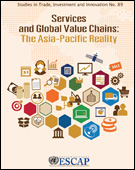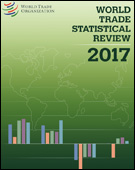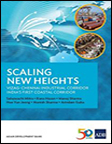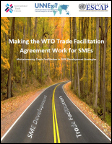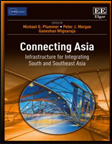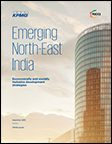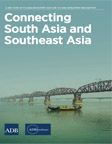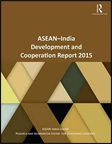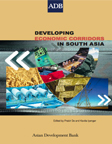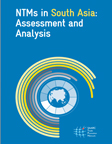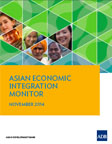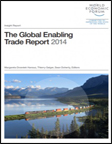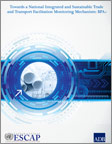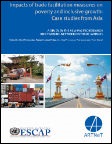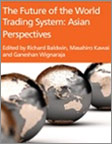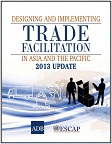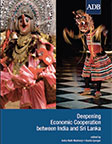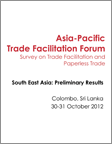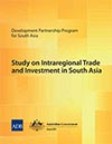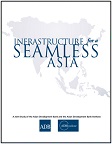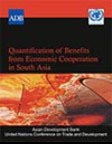Trade Facilitation Results
Trade facilitation focuses on removing barriers to the international movement of goods to lower trade costs, at and around the borders, and along the supply chain, to make countries more competitive in regional and global markets. In the SASEC subregion, bottlenecks in trade facilitation are the leading non-tariff barriers that constrain intraregional trade. SASEC initiatives in trade facilitation aims to make cross-border trade and transport in the subregion faster, cheaper, and more predictable, while maintaining the security of the supply chain and ensuring the effectiveness and efficiency of the institutions involved.
TRANSPORT INDIA
PUBLICATIONS
total items: 22This book reviews issues concerning the roles of services in global value chains. It presents a framework for assessing links among different services and between services and the manufacturing sector. The book explains the contribution of services to global value chains in the Asia-Pacific region and to the world and also draws lessons with which countries could understand the importance of services and participation in global value chains to achieving sustainable development.
The World Trade Statistical Review looks at the last 10 years and examines the latest developments in world trade, with a detailed analysis of the most recent trends for trade in goods and services. The book gives information on the participation of India, Bangladesh, and other South Asian economies in world trade, and highlights trends in the use of trade-facilitating measures. It also gives information on the implementation of the WTO Trade Facilitation Agreement and regional trade agreements, such as the South Asian Free Trade Arrangement.
Source: World Trade Organization
This book provides policymakers with a guide to understanding India’s economic corridor development strategy by examining its first coastal economic corridor, the East Coast Economic Corridor. It lays out the plan for its first phase, the Vizag–Chennai Industrial Corridor, which can help unify the country's domestic market, integrate its economy with Asia's global value chains, and support the 'Make in India' initiative to spur manufacturing through construction of world-class infrastructure supported by a major transport network, connecting urban clusters complemented by vibrant industrial zones, and encouraging a favorable and competitive environment for businesses to thrive, and facilitating efficient movement of goods and people. As a policy instrument and development strategy, economic corridors can help fast-track inclusive and sustainable economic growth, stimulate rapid industrialization and increase productivity, promote investments, and expand regional connectivity.
Source: Sabyasachi Mitra, Rana Hasan, Manoj Sharma, Hoe Yun Jeong, Manish Sharma, and Arindam Guha
Small and Medium Enterprises (SMEs) comprise 95% of enterprises worldwide and provides at least two thirds of private sector employment. However, when it comes to international trade, SMEs experience limited capacity in dealing with the complex administrative and regulatory procedures associated with moving and selling goods across borders. This book fills a gap by providing a reference for articles of the World Trade Organization (WTO) Trade Facilitation Agreement (TFA) that are particularly beneficial to SMEs, and identifies examples of SME-specific programs, measures and interventions that can support the implementation of such provisions. It proposes mainstreaming relevant elements of the WTO TFA in existing SME policies and initiatives, to ensure that it contributes toward internationalization of SMEs.
Source: UNESCAP, UNNExT, and ITC
This book contains background papers prepared for the Asian Development Bank and the Asian Development Bank Institute joint study, 'Connecting South Asia and Southeast Asia.' It emphasizes the potential contribution to growth that greater connectivity—through better transport and energy infrastructure and improved soft infrastructure, including trade facilitation—between South Asia and Southeast Asia can foster. With benefits including greater participation in global supply chains for South Asia; lower trade costs; and increase in inter- and intraregional trade, the book underscores that, at a juncture where closer regional integration can secure sustainable and inclusive growth for economies in the two regions, specific policies should be examined and considered to enable both regions to maximize gains from greater integration.
Source: Michael G. Plummer, Peter J. Morgan, Ganeshan Wignaraja, eds.
This report highlights opportunities that can be explored in India's North East region, including tourism, energy, and infrastructure, to enable the North East to develop economically, while contributing to India's development as a whole. It takes stock of recent initiatives, including the 'Look East' Policy and the Bangladesh-Bhutan-India-Nepal (BBIN) subregional grouping, and identifies areas for improvement to propel inclusive growth. Harnessing the region's full potential would require upgrading the region's infrastructure. Significant investments are needed, since lack of connectivity and inadequate infrastructure present developmental bottlenecks, contributing to the slow pace of growth in the North East. The report presents policy recommendations and suggested actions, and a forecast for India for 2021-2022.
Source: KPMG India and FICCI
This book analyzes how closer regional connectivity and economic integration between South Asia and Southeast Asia can benefit both subregions. It aims to build a broad case for increased connectivity between the two regions and identify specific projects that have high potential to fulfill this objective. This joint study focuses on both “hard” infrastructure and associated “soft” infrastructure, including tariffs and non-tariff barriers, trade and transport facilitation, energy trading, and infrastructure investment and financing. It further provides a canvas for considering strategic cross-border infrastructure investments and policy reforms.
Source: Asian Development Bank Institute and Asian Development Bank
Re-engagement between India and ASEAN through increased cooperation across a range of issues, including trade and connectivity, is set to boost prosperity, competitiveness, growth and integration. With negotiations underway to establish a comprehensive free trade area through the Regional Comprehensive Economic Partnership, economic integration between India and Southeast and East Asia is set to scale new heights – further highlighting need for economic corridors with adequate cross-border infrastructure facilities that could facilitate increased production and services networks between ASEAN and Indian economies. This Report brings together experts and researchers who weigh in on ASEAN-India relations, analyzing the impact and implications of integration; assessing policy priorities, effectiveness, implementation imperatives and challenges; and discussing themes central to the economic sustainability of the region.
Source: ASEAN–India Centre, Research and Information System for Developing Countries
This book describes key conditions for transforming transport corridors into economic corridors and establishes the rationale for developing economic corridors, and the related benefits from production value chains along those corridors. It further emphasizes the significant potential of economic corridors in South Asia, particularly those being developed under the South Asia Subregional Economic Cooperation Program. The chapters highlight the impact of trade barriers on bilateral trade and present case studies on trade facilitation in South Asia. Countries in the subregion would benefit by working closely to exploit the full economic potential of economic corridors.
Source: Asian Development Bank
The study “NTMs in South Asia: Assessment and Analysis” analyzes how Non-tariff Measures (NTMs) give rise to non-tariff barriers, which are becoming increasingly crucial for advancing trade cooperation among member countries of the South Asian Association for Regional Cooperation, yet remain less-addressed. The study examines export potential and actual export of South Asian countries, and attempts to highlight gains from reduction in transaction costs in bilateral trade. It also notes that initiatives for trade facilitation reforms in South Asia at the regional level remain low in incentives and have yet to produce significant results. The study closes with several recommendations for reducing and eliminating NTMs.
Source: Selim Raihan, Mostafa Abid Khan, and Shaquib Quoreshi
This AEIM review of recent economic performance highlights the need for Asia to rebalance its sources of growth toward domestic and regional demand. It also shows a resilient Asia with rising GDP growth in South Asia. This issue includes a Special Chapter: Regional Financial Integration and Crisis in Asia and Europe – A Comparative Analysis. It presents Asia’s future path of integration as different from that in Europe. Asia will continue to strengthen efforts to harmonize rules and regulations in the financial sector and further unilateral trade and investment, while Europe is more likely to strengthen regional institutions to ensure recovery and better the monetary union.
Source: Asian Development Bank
The Global Enabling Trade Report offers a tool to monitor progress on implementing measures for the Trade Facilitation Agreement. Benchmarking the performance of 138 economies in four critical areas, including border administration, the Report takes off from the success of the Bali package by emphasizing measures that facilitate trade at a more practical level, with benefits that significantly outweigh the cost of necessary reforms and produces positive spillover effects on other indicators—market access, infrastructure, and operating environments. Also mentioned are insights on further boosting trade facilitation within the region, such as regional cooperation and sharing of good practices. The Report is intended as a motivator for change at a time of renewed momentum for trade facilitation where windows of opportunities for policymakers to push through trade-enabling measures are open.
Source: Margareta Drzeniek Hanouz, Thierry Geiger, Sean Doherty (eds.)
This ADB-UNESCAP publication aims to provide guidance to the countries of the Asia-Pacific region on establishing a sustainable trade and transport facilitation monitoring mechanism (TTFMM). Underpinning the TTFMM is the integrated methodology of Business Process Analysis Plus (BPA+), which is built on the Business Process Analysis methodology, and supplemented by Time Release Studies (TRS) and Time-Cost-Distance (TCD) methodologies. It is envisaged that establishment of TTFMM will enable effective monitoring and enhancement of national trade facilitation on a continuous basis and in a sustainable manner.
Source: UNESCAP
This book addresses the gap between trade facilitation and poverty reduction and contains a compilation of specific case studies that explores the linkages between trade facilitation measures and poverty. It also presents cross-country analysis that examines inequality in low- and middle-income countries. Other chapters discuss economic corridors and microfinance development as trade facilitation measures and examine access to trade facilitation by export-oriented micro, small, and medium-sized enterprises. It also explores barriers to international entrepreneurship for the vegetable business in Bangladesh. Finally, it offers a comprehensive evaluation of the effectiveness of Export Processing Zones (EPZs) on poverty reduction.
Source: Ravi Ratnayake, Rajan Sudesh Ratna, Martina Francesca Ferracane and Yann Duval
According to WTO Director-General Pascal Lamy, the problems facing Asian regionalism are a scaled-down version of the problems facing the world. Thus, solutions that address Asia’s noodle bowl would most likely work at the global level. This concise collection of short chapters is based on longer papers presented at the Geneva Conference on 11-12 March 2013, organized by the Asian Development Bank Institute and Centre for Trade and Economic Integration at the Graduate Institute of International and Development Studies, in collaboration with WTO. The chapters are written by leading Asian and international trade experts on key changes taking place in the world trading system and its policy implications for Asia.
Source: Richard E. Baldwin, Masahiro Kawai, and Ganeshan Wignaraja, eds.
This reference book was published to support the implementation of trade facilitation measures and reforms in Asia and the Pacific. It includes operational guidance on assessing the status of trade facilitation, the measures and reforms needed, how to design trade facilitation initiatives, and how to implement them at national and regional levels. The book is intended to assist policy makers, practitioners, and economists by bridging the gap between theory and practice. The revised 2013 version includes updated statistical figures and data, information on actual trade facilitation policies and practices, and the most recent research on trade facilitation.
Source: Asian Development Bank / United Nations Economic and Social Commission for Asia and the Pacific
This book analyzes the performance and impact of the India-Sri Lanka free trade agreement over the past decade and suggests the way forward. India became an important source of imports for Sri Lanka immediately after the implementation of the free trade agreement.
Source: Asian Development Bank
Conducted jointly by the Asian Development Bank and the United Nations Economic and Social Commission for Asia and the Pacific, this survey provides a status snapshot of trade facilitation in place across 26 countries of the region, including progress towards establishment of national trade facilitation committees, implementation of risk management measures, development of national single windows, and steps taken to move toward paperless trade. It further examines specific issues and challenges in these areas of South East Asian countries, and provides recommendations for improvement.
Source: ADB and UNESCAP
This study broadens and deepens intraregional cooperation and integration in trade and investment among South Asian countries. It showcases the benefits of regional integration and presents an array of policy recommendations to maximize and realize such gains. Three parallel initiatives are needed: first, reduce nontariff barriers to deepen the South Asian Free Trade Area (SAFTA); second, expand SAFTA's scope to include investments and services; and third, focus on key industries to succinctly demonstrate the process and benefits of reforms. These translate into six component studies: (i) the Role of Trade Facilitation in South Asian Economic Integration; (ii) Country Investment Studies for Bangladesh, India, Nepal, and Sri Lanka; and (iii) Textile and Clothing Industry. The study invigorates the debate and focus on South Asian integration as a means to further growth and reduce poverty.
In today's globalized world where the economic fates of nations are inevitably linked, weathering the present economic storm for Asia will increasingly depend on harnessing regional dynamics particularly on the trade front. Pan-Asian Integration: Linking East and South Asia is a rich volume of perspectives from leading thematic experts on regional patterns of trade and investment, trade-related infrastructure, trade facilitation, among others.
Source: Asian Development Bank
The study reviews regional infrastructure being enhanced through regional cooperation in Asia and examines major issues and challenges. It suggests a framework for pan-Asian infrastructure cooperation, anchored on a long-term vision of creating a seamless Asia that will not only enhance the region's competitiveness and extend its global reach, but also help reduce poverty and promote greater environmental sustainability.
Source: Asian Development Bank / Asian Development Bank Institute
The study examines the implication of the South Asian Free Trade Agreement (SAFTA) on South Asian countries and on the region as a whole, employing both a quantitative and qualitative assessment on the outcomes of SAFTA. The research aims to provide support in the formulation of concrete policy measures for trade to ensure greater gains for the region, while at the same time mitigating potential negative impacts. Economic and social assessments through analytical tools and rational causal chain analysis further enrich the study.
Source: Asian Development Bank / United Nations Conference on Trade and Development

